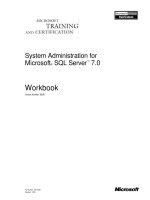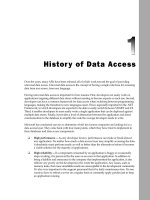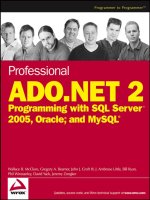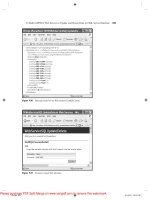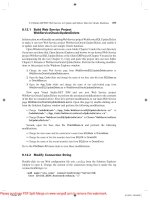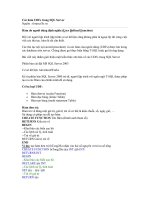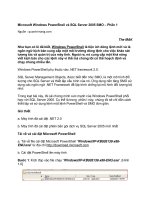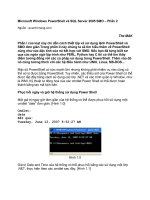Tài liệu Practical Business Intelligence with SQL Server 2005 docx
Bạn đang xem bản rút gọn của tài liệu. Xem và tải ngay bản đầy đủ của tài liệu tại đây (13.1 MB, 439 trang )
Practical Business Intelligence with SQL Server 2005
By John C. Hancock, Roger Toren
Publisher: Addison Wesley Professional
Pub Date: August 28, 2006
Print ISBN-10: 0-321-35698-5
Print ISBN-13: 978-0-321-35698-7
Pages: 432
Table of Contents | Index
Design, Build, and Manage High-Value BI Solutions with SQL Server 2005
In this book, two of Microsoft's leading consultants illustrate how to use SQL Server 2005 Business
Intelligence (BI) technologies to solve real-world problems in markets ranging from retail and
finance to healthcare. Drawing on extensive personal experience with Microsoft's strategic
customers, John C. Hancock and Roger Toren offer unprecedented insight into BI systems design
and step-by-step best practices for implementation, deployment, and management.
Hancock and Toren introduce practical BI concepts and terminology and provide a concise primer on
the Microsoft BI platform. Next, they turn to the heart of the bookconstructing solutions. Each
chapter-length case study begins with the customer's business goals, and then guides you through
detailed data modeling. The case studies show how to avoid the pitfalls that derail many BI
projects. You'll translate each model into a working system and learn how to deploy it into
production, maintenance, and efficient operation.
Whether you're a decision-maker, architect, developer, or DBA, this book brings together all the
knowledge you'll need to derive maximum business value from any BI project.
• Leverage SQL Server 2005 databases, Integration Services, Analysis Services, and Reporting
Services
• Build data warehouses and extend them to support very large databases
• Design effective Analysis Services databases
• Ensure the superior data quality your BI system needs
• Construct advanced enterprise scorecard applications
• Use data mining to segment customers, cross-sell, and increase the value of each transaction
• Design real-time BI applications
• Get hands-on practice with SQL Server 2005's BI toolset
Practical Business Intelligence with SQL Server 2005
By John C. Hancock, Roger Toren
Publisher: Addison Wesley Professional
Pub Date: August 28, 2006
Print ISBN-10: 0-321-35698-5
Print ISBN-13: 978-0-321-35698-7
Pages: 432
Table of Contents | Index
Design, Build, and Manage High-Value BI Solutions with SQL Server 2005
In this book, two of Microsoft's leading consultants illustrate how to use SQL Server 2005 Business
Intelligence (BI) technologies to solve real-world problems in markets ranging from retail and
finance to healthcare. Drawing on extensive personal experience with Microsoft's strategic
customers, John C. Hancock and Roger Toren offer unprecedented insight into BI systems design
and step-by-step best practices for implementation, deployment, and management.
Hancock and Toren introduce practical BI concepts and terminology and provide a concise primer on
the Microsoft BI platform. Next, they turn to the heart of the bookconstructing solutions. Each
chapter-length case study begins with the customer's business goals, and then guides you through
detailed data modeling. The case studies show how to avoid the pitfalls that derail many BI
projects. You'll translate each model into a working system and learn how to deploy it into
production, maintenance, and efficient operation.
Whether you're a decision-maker, architect, developer, or DBA, this book brings together all the
knowledge you'll need to derive maximum business value from any BI project.
• Leverage SQL Server 2005 databases, Integration Services, Analysis Services, and Reporting
Services
• Build data warehouses and extend them to support very large databases
• Design effective Analysis Services databases
• Ensure the superior data quality your BI system needs
• Construct advanced enterprise scorecard applications
• Use data mining to segment customers, cross-sell, and increase the value of each transaction
• Design real-time BI applications
• Get hands-on practice with SQL Server 2005's BI toolset
Practical Business Intelligence with SQL Server 2005
By John C. Hancock, Roger Toren
Publisher: Addison Wesley Professional
Pub Date: August 28, 2006
Print ISBN-10: 0-321-35698-5
Print ISBN-13: 978-0-321-35698-7
Pages: 432
Table of Contents | Index
Copyright
Microsoft Windows Server System Series
Acknowledgments
About the Authors
Preface
Chapter 1. Introduction to Business Intelligence
What Is Business Intelligence?
Transaction Systems and the Search for
Information
Data Warehouses
OLAP to the Rescue
Dimensional Modeling Concepts
A Practical Approach to Dimensional Modeling
Business Intelligence Projects
Summary
Chapter 2. Introduction to SQL Server 2005
SQL Server Components
SQL Server Database Engine
Integration Services
Analysis Services
Reporting Services
Data Mining
Other Technologies
Summary
Chapter 3. Building a Data Warehouse
Business Problem
Solution Overview
Data Model
Technical Solution
Managing the Solution
Next Steps
Summary
Chapter 4. Building a Data Integration Process
Business Problem
Solution Overview
Data Model
Technical Solution
Managing the Solution
Next Steps
Summary
Chapter 5. Building an Analysis Services Database
Business Problem
Solution Overview
Data Model
Technical Solution
Managing the Solution
Next Steps
Summary
Chapter 6. Reporting
Business Problem
Solution Overview
Data Model
Technical Solution
Managing the Solution
Next Steps
Summary
Chapter 7. Data Quality
Business Problem
Solution Overview
Data Model
Technical Solution
Managing the Solution
Next Steps
Summary
Chapter 8. Managing Changing Data
Business Problem
Solution Overview
Data Model
Technical Solution
Managing the Solution
Next Steps
Summary
Chapter 9. Scorecards
Business Problem
Solution Overview
Data Model
Technical Solution
Managing the Solution
Next Steps
Summary
Chapter 10. Data Mining
Business Problem
Solution Overview
Data Model
Technical Solution
Managing the Solution
Next Steps
Summary
Chapter 11. Very Large Data Warehouses
Business Problem
Solution Overview
Data Model
Technical Solution
Managing the Solution
Next Steps
Summary
Chapter 12. Real-Time Business Intelligence
Business Problem
Solution Overview
Data Model
Technical Solution
Managing the Solution
Next Steps
Summary
Index
Copyright
Many of the designations used by manufacturers and sellers to distinguish their products are claimed
as trademarks. Where those designations appear in this book, and the publisher was aware of a
trademark claim, the designations have been printed with initial capital letters or in all capitals.
The authors and publisher have taken care in the preparation of this book, but make no expressed or
implied warranty of any kind and assume no responsibility for errors or omissions. No liability is
assumed for incidental or consequential damages in connection with or arising out of the use of the
information or programs contained herein.
The publisher offers excellent discounts on this book when ordered in quantity for bulk purchases or
special sales, which may include electronic versions and/or custom covers and content particular to
your business, training goals, marketing focus, and branding interests. For more information, please
contact:
U.S. Corporate and Government Sales
(800)382-3419
For sales outside the U.S., please contact:
International Sales
Visit us on the Web: www.awprofessional.com
Copyright © 2007 Pearson Education, Inc.
All rights reserved. Printed in the United States of America. This publication is protected by copyright,
and permission must be obtained from the publisher prior to any prohibited reproduction, storage in a
retrieval system, or transmission in any form or by any means, electronic, mechanical, photocopying,
recording, or likewise. For information regarding permissions, write to:
Pearson Education, Inc.
Rights and Contracts Department
One Lake Street
Upper Saddle River, NJ 07458
Text printed in the United States on recycled paper at R.R. Donnelley & Sons in Crawfordsville,
Indiana. First printing, September 2006
Library of Congress Cataloging-in-Publication Data
Hancock, John C. (John Christian), 1973-
Practical business intelligence with SQL Server 2005 / John C. Hancock, Roger Toren.
p. cm.
Includes bibliographical references and index.
ISBN 0-321-35698-
5 (pbk. : alk. paper) 1. Business intelligence. 2. SQL server. 3. Client/server computing. I. Toren, Roger. II. Title.
HD38.7.H36 2006
005.75'85dc22
2006017671
Microsoft Windows Server System Series
Books in the Microsoft Windows Server System Series are written and reviewed by the world's
leading technical authorities on Microsoft Windows technologies, including principal members of
Microsoft's Windows and Server Development Teams. The goal of the series is to provide reliable
information that enables administrators, developers, and IT professionals to architect, build, deploy,
and manage solutions using the Microsoft Windows Server System. The contents and code of each
book are tested against, and comply with, commercially available code. This series should be an
invaluable resource for any IT professional or student working in today's Windows environment.
Titles in the Series
Paul Bertucci, Microsoft SQL Server High Availability, 0-672-32625-6 (Sams)
Peter Blackburn and William R. Vaughn, Hitchhiker's Guide to SQL Server 2000 Reporting Services,
0-321-26828-8 (Addison-Wesley)
William Boswell, Learning Exchange Server 2003, 0-321-22874-X (Addison-Wesley)
Roberta Bragg, Windows Server 2003 Security, 0-321-30501-9 (Addison-Wesley)
Eric L. Brown, SQL Server 2005 Distilled, 0-321-34979-2 (Addison-Wesley)
Bill English, Olga Londer, Shawn Shell, Todd Bleeker, and Stephen Cawood, Microsoft Content
Management Server 2002: A Complete Guide, 0-321-19444-6 (Addison-Wesley)
John C. Hancock and Roger Toren, Practical Business Intelligence with SQL Server 2005, 0-321-
35698-5 (Addison-Wesley)
Don Jones, Managing Windows® with VBScript and WMI, 0-321-21334-3 (Addison-Wesley)
Sakari Kouti and Mika Seitsonen, Inside Active Directory, Second Edition: A System Administrator's
Guide, 0-321-22848-0 (Addison-Wesley)
Jason Nadrowski and Stacy Draper, SharePoint 2003 Advanced Concepts, 0-321-33661-5 (Addison-
Wesley)
Shyam Pather, Microsoft SQL Server 2000 Notification Services, 0-672-32664-7 (Sams)
Jeffrey R. Shapiro and Marcin Policht, Building High Availability Windows Server™ 2003 Solutions, 0-
321-22878-2 (Addison-Wesley)
Buck Woody, Administrator's Guide to SQL Server 2005, 0-321-39797-5 (Addison-Wesley)
For more information please go to www.awprofessional.com/msserverseries
We would like to thank Jan Shanahan of Microsoft for her early support of the project and practical
advice, without which this book may never have got off the ground.
We would like to thank our colleagues at Microsoft Consulting Services in Canada for their help:
Simona Marin, Shaun Tinline-Jones, and Tamer Farag for working through the text and providing
feedback; Jonathan Stynder, for SharePoint assistance; Vince Bryden, for professional services
metrics advice; and Rob Wood, for a wealth of practical e-commerce advice. We want to thank
Darren Massel for early encouragement and extensive feedback on the book as it progressed. We are
also grateful to our manager, Steven Major, whose support and enthusiasm from the beginning was
invaluable in keeping us going.
We also need to thank many members of the SQL Server product teams for taking the time to work
with us on their areas of expertise in the textany remaining errors that we may have managed to
sneak past them are purely a reflection of our own stubbornness. In particular, we want to thank
Zhaohui Tang and Jamie MacLennan for data mining advice, Dave Wickert for real-world advice, and
especially Thierry D'Hers for his extensive and valuable feedback.
We also want to thank the great team at Addison-Wesley for their professionalism and patience, and
all of the reviewers for their input.
Roger would like to thank his family, Nadine, Erik, and Julia, for their patience on this journey. He
would also like to thank many of the customers he has worked with from Toronto to Tokyo for their
great questions and the opportunity to work with them on their business problems, which helped to
frame much of the content of our book.
John would like to thank his wife, Nicolette, for her enthusiasm and encouragement throughout the
long book project. He would also like to thank his family for all their support, and in particular Dr. J.
D. Hancock for his precedent-setting early practical work. John would like to dedicate his work on this
book to Rita Smith for her encouragement of him and so many others, and to Irene Mosley for her
kindness and support.
About the Authors
John C. Hancock is a Senior Consultant with Microsoft Consulting Services in Toronto, Canada,
specializing in Business Intelligence technologies. He has worked with some of Microsoft's largest and
most strategic clients, and his consulting experience has included architectural consulting, project
team lead positions, performance optimization, and development of customized training courses and
materials. Recently he has worked extensively in the field of intelligence systems for law
enforcement. Prior to Microsoft, he worked as an independent consultant in the United Kingdom and
South Africa. He holds a Bachelor of Science (Honors) degree in mathematics and computer science.
Roger Toren is a Principal Consultant with MCS, based in Vancouver, Canada, focusing on guiding
customers in the design and implementation of Business Intelligence solutions with SQL Server 2005.
He was the lead author on the SQL Server 2000 High Availability guide. He has more than 35 years
of experience in IT, covering a wide variety of industries, including banking, insurance, retail,
education, health care, geo-spatial analysis, and nuclear research. He holds a Bachelor of Science
degree in physics and a Masters of Science degree in computing science. Prior to joining Microsoft, he
taught undergraduate courses in computing science, worked as an independent consultant, and
served as Associate Director in the technology practice of a major global consulting firm.
About the Technical Editor
Bob Reinsch is a senior technical trainer for Foss Training Center in Leawood, Kansas. He has been
a Microsoft Certified Trainer and Systems Engineer for 10 years, and he resides in Lawrence, Kansas,
with his wife and three kids. When he is not in the classroom, consulting on messaging or security
matters, or spending time with his family, he can be found either strumming a guitar or building a
new one. He can be contacted at
Chapter 1. Introduction to Business
Intelligence
Before looking at building Business Intelligence (BI) solutions with SQL Server 2005, it's important to
get an understanding of the underlying concepts. This chapter covers the basics of what makes BI
systems different from transaction systems and looks at some modeling techniques and technologies
for providing the performance and flexibility that users need. We end the chapter by providing some
practical project advice and point out some of the pitfalls of BI projects.
What Is Business Intelligence?
Business Intelligence is a set of concepts, methods, and technologies designed to pursue the elusive
goal of turning all the widely separated data in an organization into useful information and eventually
into knowledge.
This information has historically been delivered to an organization's analysts and management
through reporting and analysis capabilities, but increasingly BI is being delivered to all parts of an
organization by integrating smarter capabilities into the applications and tools that people use to
perform their everyday jobs. The most successful BI solutions can create exceptionally valuable
capabilities for an organization, such as the ability to proactively spot opportunities to increase
revenue or improve operational processes and practices.
In the past, BI projects have often suffered from over-hyped attempts to highlight the potential value
without consideration of the work that is required within an organization. Simply building a BI
capability doesn't mean that it will easily be able to move off the whiteboards and out of the server
rooms and into the hands of a user community that is ready and prepared to do something with the
information. The best BI solutions pay as much attention to the "business" as the "intelligence," and
in this book we look at both sides with a focus on the practical aspects required for success.
Transaction Systems and the Search for Information
Every company of a reasonable size has some major systems that run the business. These systems
are known as OLTP (online transaction processing) systems and are often responsible for the
vital processes such as handling orders and invoices. Because of their key role, they usually end up
storing the most critical information that the business relies on, such as the list of how much money
customers owe or how much the company owes in tax.
Most OLTP systems handle many thousands of individual transactions in a day. The goals of
transaction systems are primarily to provide consistency of the information and the ability to support
additions and modifications to typically small pieces of data at a time. These requirements are fairly
standard across many OLTP systems and have led to the broad adoption of a specific approach to
organizing the data in these databases.
The data model for these systems is usually produced through a process of entity-relationship (ER)
modeling, which leads to a normalized structure in which each entity has its own separate table that
is related to the others, as shown in Figure 1-1. The normalized data model is a great fit for OLTP's
requirements because it ensures that every piece of information exists only in one place and can be
updated easily and efficiently.
Figure 1-1. OLTP database schema
[View full size image]
These data models typically contain dozens or even hundreds of separate tables, most of which are
connected to the others through large numbers of relationships. The normalized relational database
has become such a common feature of systems that many database administrators (DBAs) and
application designers can glance at a new report and automatically form a picture in their heads of a
normalized data model that would fit.
Many people use reports directly from their company's enterprise resource planning (ERP) system or
other major systems all the time, but the kind of information that can easily be retrieved is restricted
by the design and purpose of a transaction system. Using operational systems for standard reporting
works well for operational-level data such as reports on specific customer records or order
transactions, but trying to understand your entire business by analyzing detailed transactions is
unlikely to prove successful.
Why OLTP Reporting and Analysis Fails to Deliver
The really interesting questions that business users would like to answer almost always touch much
more data than single transactions or records, such as "Which product category sold best in the
northwest last year?" followed by "So, what kinds of customers were buying that product category in
the region?."
OLTP systems are the systems that run a business. The OLTP system is a "live" picture of the current
state of the business that is changing underneath the users as they do their analysis. If they run one
report that shows the totals by region, then another report that shows the details, the totals might
not correspond if more data has been entered in between running the reports. Also, trying to use
these systems to actually understand the business as it runs is a risky proposition because it will
almost certainly affect the performance and availability of system resources.
Every interesting query against the OLTP schema shown in Figure 1-1 will likely involve lots of
different tables and joins with filters against the data. The performance of those queries is probably
not going to be good for any database of reasonable size, regardless of the hardware and software
you are using. Even optimizing the tables for this kind of query is usually not an option: Remember
that OLTP systems must first and foremost provide fast, atomic updates.
One of the most important reasons that OLTP systems fail to deliver BI is related to the restricted
ways that users can access the information, which is usually via static or parameterized reports that
were designed and published by the IT department. Because of the complexity of the database and
the performance implications of a user possibly launching a huge, poorly designed query that takes
eight hours to complete on the live OLTP system, the users are restricted to accessing specific sets of
information in a prescribed way.
The promise of "end-user reporting" tools that people could use to create their own reports on their
desktops never really materialized. Even when reporting tools started to get user-friendly Windows
interfaces, the complexity of the schema in the transaction systems defeated most attempts to
provide access directly to users. Ultimately, they are still restricted by the database design and the
operational requirements for the transaction system.
Despite all the drawbacks we have just described, there is an even more compelling problem with
trying to use an OLTP system directly as the vehicle for intelligent analysis. Every organization we
have ever worked with has valuable information that is spread out in different areas, from the HR
department's system to the spreadsheet that contains next year's budget. The solution to the
problem of providing access to information must lie outside a single transaction system. The solution
lies in a separate system: a data warehouse.
Data Warehouses
The data warehouse is the place where a consistent view of an organization's data can be published
for users to be able to access it. The first characteristic of the data warehouse is that it is separate. If
we are really serious about providing easy access to all the information, we have to create a separate
relational database with a design and an operational approach that is optimized for queries rather
than atomic transactionsthis is the data warehouse.
Data from all the source systems is loaded into the warehouse (see Figure 1-2) through a process of
extraction, transformation, and loading that produces a clean, validated repository of information.
This information is organized and presented to the users in a way that enables them to easily
formulate their business questions, and the answers are returned orders of magnitudes faster than
similar queries against the transaction systems so that the users can immediately reformulate their
question and get more details.
Figure 1-2. Data warehouse loaded from source systems
The Data Warehouse Design
The data warehouse is still a relational database, but that doesn't mean we are constrained to stick
to the fully normalized, entity-relationship (ER) schema that is so appropriate for OLTP systems. Over
time, the various approaches to designing a database schema that is optimized for understanding and
querying information have been consolidated into an approach called a dimensional model.
At the center of the dimensional model are the numeric measures that we are interested in
understanding, such as sales revenue or profit margins. Related measures are collected into fact
tables that contain columns for each of the numeric measures. Every time something measurable
happens, such as a sales transaction, an inventory balance or when an event occurs, a new record is
added to the fact table with these numeric values.
There are usually many different ways that people can look at these measures. For example, they
could look at totals for a product category or show the totals for a particular set of stores. These
different ways of looking at the information are called dimensions, where a dimension is a particular
area of interest such as Product, Customer, or Time. Every dimension table has a number of columns
with descriptive text, such as product category, color, and size for a Product dimension. These
descriptive columns are known as attributes; the more interesting attributes you can make available
to users, the better.
The resulting database schema consists of one or more central fact tables, and a number of
dimension tables that can be joined to these fact tables to analyze them in different ways. This
design is usually known as a star schema because of the shape, as shown in Figure 1-3.
Figure 1-3. Star schema
If you have a strong background in OLTP databases, the idea of not necessarily normalizing data is
probably at this moment causing you to reconsider the money you just spent on this book. Rest
assured: We are not advocating ditching normalization altogether, but this is just one tool in our kit.
Dimensional databases have different purposes, and different constraints. We can make appropriate
decisions about the correct design of a particular database by looking at the ways it will be used,
rather than necessarily trying to apply standard OLTP designs to every database.
Time and the Data Warehouse
Probably the most important dimension in any data warehouse is the Time dimension. This is the
dimension that allows users to summarize the information in the fact tables in a way that matches up
to the real world. They can use this dimension to look at totals for the current calendar year or to
compare the percentage improvement over the previous fiscal period, for example. Although modern
query languages have many flexible functions for working with date values, the best way to
accommodate all the real-world complexities of analyzing information by time is to add a Time
dimension table to the data warehouse, loaded with records starting from the earliest fact record that
is available.
An important characteristic of the data warehouse is that it stores history. This idea is often
misinterpreted because OLTP systems also store transactions going back in time (some for many
years), so why is this feature of the data warehouse so important? Actually, there is a lot more to
storing history accurately than just keeping a set of transactions around. For example, if every sales
manager in the OLTP system is related to a set of customers in a sales territory, what happens when
the sales territories' boundaries have been updated and you try to run an analysis for previous
calendar years? The data warehouse must be capable of accurately reproducing the state of the
business in the past as well as the present.
Most measures in a fact table are additive. That is, all the numbers can be added up across any
time period that a user selects, whether that is a single day or several months. The benefit of
additive measures is that they can easily be used to create summaries by simply summing the
numbers. Some measures may not be additive across time periods or some other dimension and are
known as semi-additive. Examples of these include monthly balances such as inventory on hand or
account balances.
Getting Data into the Data Warehouse
Because the data warehouse is separate from all the other systems, an important part of the data
warehouse process is copying data from the various source systems, restructuring it as necessary,
and loading it into the warehouse. This process is often known as ETL, or extraction, transformation,
and loading, sometimes with an additional M on the end (ETLM) to remind us of the need to actively
manage this process.
The exact approach that you take for a given data warehouse depends on a lot of factors such as the
nature of the source systems and business requirements for timely data, but a typical ETL process is
a batch process that is run on a daily or weekly basis. The first part of the process involves extracting
data from the source systems, either through direct queries against the systems using a data access
interface such as ODBC or OLE DB or through the export of data files from within the systems.
This source data is then transformed into the correct format, which involves the obvious tasks such
as matching data types and formats but also more complex responsibilities such as checking that
valid business keys are supplied. When the data is in the right format, it is added to the data
warehouse tables. Fact table loading usually involves appending a new set of records to the existing
set of records for a particular date range. Updates to fact records are relatively uncommon in
practice, but you can accommodate them with some special handling.
Dimension table loading often involves appending new records, but sometimes takes the form of
updates to the attributes on existing records. These updates can have the unfortunate side effect of
destroying our ability to look at historical data in the context that existed at that time. If it is
important for a particular dimension to preserve the ability to look at data using the attribute values
that existed in the past, the dimension is known as a slowly changing dimension (SCD), and
Chapter 8, "Managing Changing Data," describes some well-established techniques for dealing with
this.
Some ETL processes include a temporary database called a staging database, which is used to
store a copy of the data that is currently being processed on the way to the data warehouse. The
data in the staging area can then be manipulated by very efficient SQL operations such as joins. The
disadvantage of having a staging area is that the data needs to be written more than once on the
way from the source system into the data warehouse, which can add a lot of overhead to the
process. SQL Server's ETL facilities use a "pipeline" approach that can often address all the ETL
requirements without requiring a data staging step.
The best way to think of ETL is not as a process of copying and transforming data from one system to
another, but rather as a process of publishing data. The publishing process includes a great deal of
focus on data quality and provides a management process to catch any errors or omissions and
correct them before the users can access the information.
What Is the Difference Between a Data Warehouse and a Data
Mart?
The difference between the terms data warehouse and data mart is largely a matter of
perspective. A data mart was classically an initiative within a single department with a
specific subject area, such as a "Marketing Data Mart" or a "Finance Data Mart." These
projects were usually undertaken in isolation without a consistent vision across the
company, so this approach led to problems because there was no driver to agree on
consistent dimensions across these data marts.
In contrast, a centralized data repository that served multiple communities in the
organization was termed a data warehouse, or enterprise data warehouse. Data marts
would sometimes use this central data warehouse as a source of information.
In this book, we stick with the term data warehouse whenever we are referring to the
dimensional relational database, which is the source for all of our BI capabilities.
In summary, our proposed approach is to build a consistent relational data warehouse with a
dimensional schema optimized for queries. Even so, real-world applications often involve millions or
billions of transactions with complex ad-hoc queries, and even the best relational query engine is
going to take some time to return information. Because our goals are to provide fast and intuitive
access to information, is relational database technology the best we can do?
OLAP to the Rescue
Relational databases have become so popular and ubiquitous that many IT professionals think that
every data storage and querying problem can (and should) be solved by a relational database.
Similarly, when XML was first popularized, many people thought exactly the same thing about XML.
The reality of course is that although structures such as relational databases and XML files have a
wide range of uses, we should follow a practical rather than dogmatic approach and apply the right
tool for the job.
Any BI solution that we put in place should ideally be available across the whole company, follow a
multidimensional approach that matches up with the real-world concepts, be easy to use by
nontechnical users, and have really great performance. This is quite a tall order, but the technology
to achieve all of this is available.
On-Line Analytical Processing (OLAP) is a different kind of database technology designed specifically
for BI. Instead of organizing information into tables with rows and columns like a relational database,
an OLAP database stores data in a multidimensional format. Rather than trying to get a relational
database to meet all the performance and usability needs we described previously, we can build an
OLAP database that the users can query instead and periodically load it with data from the relational
data warehouse, as shown in Figure 1-4. SQL Server includes an OLAP database engine called
Analysis Services.
Figure 1-4. Source to DW to OLAP to users flow
[View full size image]
The central concept in an OLAP database is the cube. An OLAP cube consists of data from one or
more fact tables and presents information to the users in the form of measures and dimensions.
OLAP database technology also generally includes a calculation engine for adding complex analytical
logic to the cube, as well as a query language. Because the standard relational query language, SQL,
is not well suited to working with cubes and dimensions, an OLAP-specific query language has been
developed called MDX (Multidimensional Expressions), which is supported by several OLAP database
engines.
The term cube comes from the general idea that the data structure can contain many dimensions
rather than just a two-dimensional table with rows and columns. Because a real-life geometric cube
is a three-dimensional object, it is tempting to try and explain OLAP technology using that metaphor,
but it quickly becomes confusing to many people (including the authors!) because most OLAP cubes
contain more than three dimensions. Suffice to say, a cube is a data structure that allows numeric
measures to be analyzed across many different dimensions.
Loading Information into OLAP Databases
As you have seen in the section on ETL, data from source systems is transformed and loaded into the
relational data warehouse. To make this data available to users of the OLAP database, we need to
periodically process the cube. When a cube is processed, the OLAP engine issues a set of SQL
queries against the relational data warehouse and loads the resulting records into an OLAP cube
structure.
In principle, an OLAP cube could be loaded directly from the source systems and instantly provide a
dimensional model for accessing the information and great performance. In that case, why do we
need a relational data warehouse as well? The most important reason is data quality. The data
warehouse contains consolidated, validated, and stable information from many source systems and is
always the best source of data for an OLAP cube.
Getting Information out of OLAP Databases
Users usually interact with a relational database (including a data warehouse) by running predefined
reports that are either created for them by IT departments or built by the users themselves using a
report writing application. Reports can often take several minutes to run even in a well-designed star
schema data warehouse, which doesn't lend itself to the kinds of interactive queries that can really
allow the user to understand new information.
The key to the success of using OLAP databases in an interactive, user-friendly way is their
performance. Queries against an OLAP cube, even ones that summarize years of history and huge
amounts of transactions, typically return results in a couple of seconds at most, which is orders of
magnitude faster than similar relational queries. This makes it feasible to build client applications that
allow users to build queries by dragging and dropping measures and dimension attributes and see
results almost instantly.
Many users, especially analysts and other power users, have conventionally used rich BI client
applications specifically designed for querying OLAP databases. These tools typically include features
such as charting and visualization and can really improve the effectiveness of analytical tasks. As the
need for access to information becomes more widespread across the organization, BI capabilities are
being included in tools that most people have access to, such as Web portals and Excel spreadsheets.
Information is often presented at a summarized level with the ability to drill down to see more
details (that is, to pick a particular area of interest and then expand it). For example, someone may
begin with looking a list of sales revenue against quota for all the geographic regions in a country and
see that a particular region has not reached their target for the period. They can highlight the row
and drill down to see all the individual cities within that region, to try and understand where the
problem may be.
Why Is OLAP So Fast?
So how does an OLAP database engine achieve such great performance? The short answer is pretty
simple: It cheats. When somebody runs an adhoc query that asks for a total of all sales activity in a
certain region over the past three years, it is very unlikely that a database engine could sum billions
of records in less than a second. OLAP solves this problem by working out some of the answers in
advance, at the time when the cube is processed.
In addition to the detailed fact data, OLAP cubes also store some precalculated summaries called
aggregates. An example of an aggregate is a set of totals by product group and month, which would
contain far fewer records than the original set. When a query is executed, the OLAP database engine
decides whether there is an appropriate aggregate available or whether it needs to sum up the
detailed records themselves. A properly tuned OLAP database can respond to most queries using
aggregates, and this is the source of the performance improvement.
If you try to work out the total possible number of different aggregates in a cube with a reasonable
number of dimensions, you will quickly realize that the number of combinations is staggering. It is
clear that OLAP database engines cannot efficiently store all possible aggregations; they must pick
and choose which ones are most effective. To do this, they can take advantage of the situation shown
in Figure 1-5. Because products roll up to product categories, and months roll up to quarters and
years, if an aggregate on product by month is available, several different queries can quickly be
answered. If a query is executed that calls for totals by year and product category, the OLAP
database engine can sum up the records in the product by month aggregate far more quickly than
using the detailed records.
Figure 1-5. OLAP aggregations
[View full size image]
Another key to OLAP database engine performance is where and how they store the detailed and
aggregated data. There are a few different approaches to this question, but the most common
answer is for the OLAP database engine to create optimized structures on disk. This approach is
known as MOLAP, or Multidimensional OLAP. Modern platforms such as Analysis Services can
support billions of records in highly optimized, compressed MOLAP structures.
Regardless of whether a query is answered from a precalculated aggregate or the detail-level records
themselves, every query is answered completely from the MOLAP structure. In fact, after the daily
cube processing has loaded data into the cube, you could even stop the relational database server
without affecting cube users, because the relational database is never used for end-user queries
when using MOLAP structures.
In some older technologies, MOLAP did not scale well enough to meet everybody's needs, so some
analytical solutions stored the detailed information and the aggregates in relational database tables
instead. In addition to a fact table, there would also be many tables containing summaries. This
approach is known as ROLAP, or Relational OLAP. Although these solutions scaled relatively well,
their performance was typically not as good as MOLAP solutions, so HOLAP (Hybrid OLAP) solutions
were introduced that stored some of the information in relational tables and the rest in MOLAP
structures.
The good news is that as far as Analysis Services is concerned, the preceding discussion is no longer
a real issue. Analysis Services supports all three approaches by simply changing a setting on the
cube, and the current version will have no trouble supporting huge data volumes with excellent
performance, leaving you free to concentrate on a more interesting question: How should you
structure the information in your particular BI solution?
Dimensional Modeling Concepts
So far we have looked at several of the key dimensional concepts, including dimensions, attributes,
measures, and fact tables. You need to understand a few other areas before we can move on to
actually building a BI solution.
Hierarchies
As you have seen, dimensions consist of a list of descriptive attributes that are used to group and
analyze information. Some of these attributes are strongly related, and can be grouped into a
hierarchy. For example, product category, product subcategory and product stock-keeping unit
(SKU) could be grouped into a hierarchy called Product Categorization. When the hierarchy is used in
a query, the results would show the totals for each product category, and then allow the user to drill
down into the subcategories, and then into the product SKUs that make up the subcategory, as
shown in Figure 1-6.
Figure 1-6. Product hierarchy drilldown
[View full size image]
